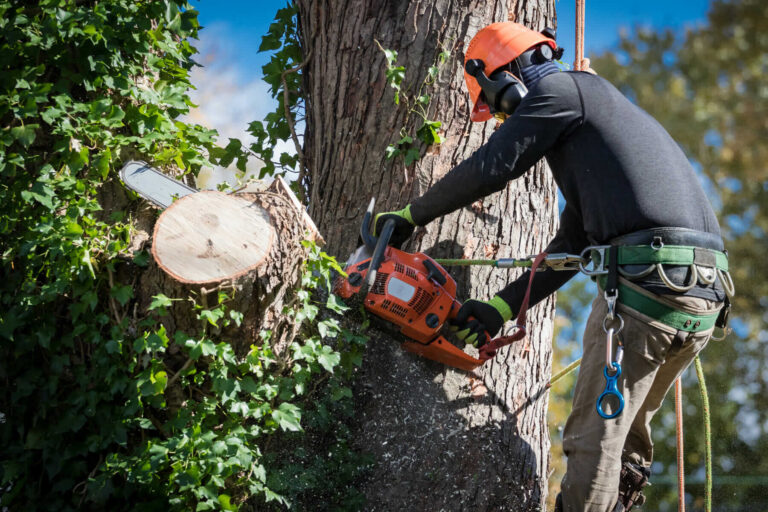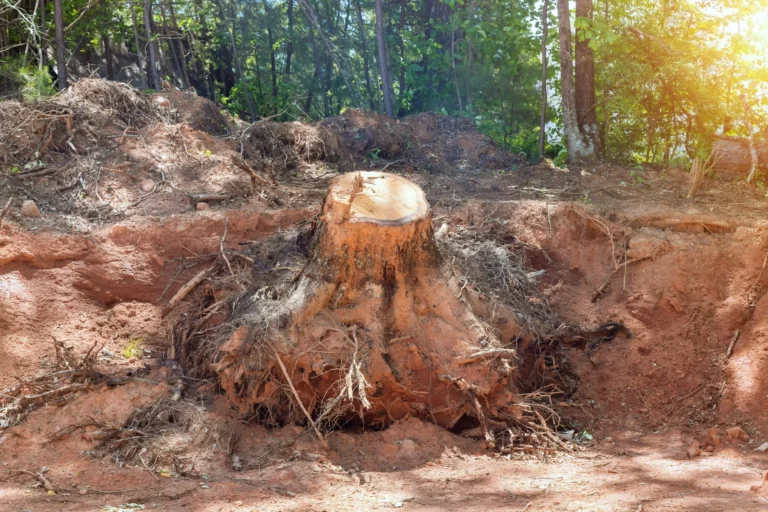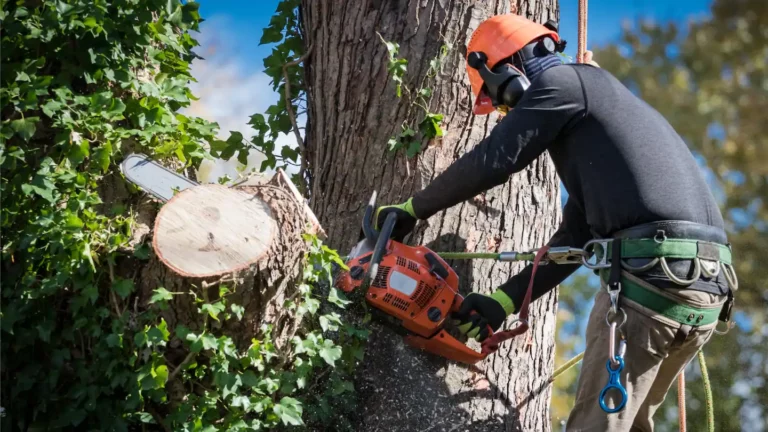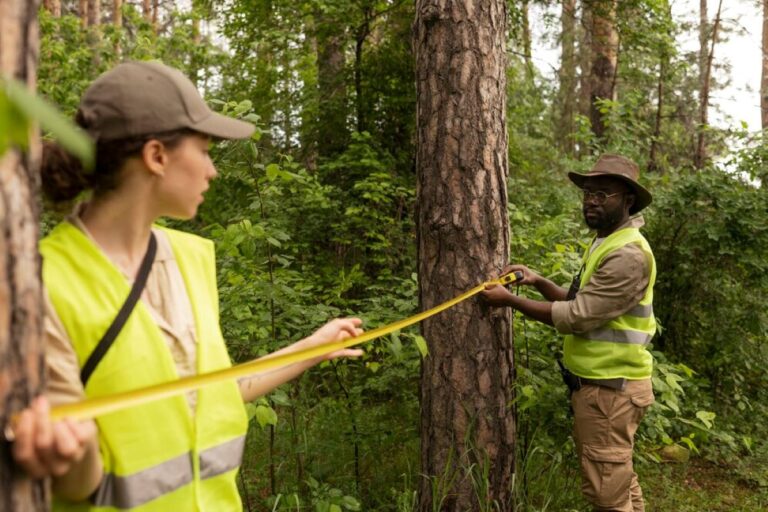The Benefits of Tree Lopping for Healthier, Stronger Trees
Tree lopping is different from regular pruning and cutting down a tree. It is a specialised technique used by arborists. Pruning involves making small cuts to the tree, while cutting down a tree means removing it completely. Lopping, on the other hand, involves making significant but careful cuts to the branches in order to maintain and improve the health of the tree.
This technique is an important way to take care of trees that are facing various problems:
- Disease Management: Removing affected branches before issues spread
- Structural Enhancement: Reducing weight on heavy limbs
- Safety Improvement: Eliminating hazardous branches
- Growth Stimulation: Directing energy to healthy sections
When done correctly, tree lopping can have several benefits for the health and safety of trees:
- Improved air circulation through the canopy
- Enhanced sunlight penetration to inner branches
- Reduced risk of storm damage
- Better distribution of nutrients throughout the tree
- Controlled growth patterns for optimal development
Professional tree removal Sydney know how to find the right balance between removing excess growth and keeping the tree’s natural shape. This knowledge ensures that trees receive proper care while still maintaining their structure and promoting long-term health.
The benefits of strategic tree lopping go beyond just making immediate improvements to how a tree looks. It also helps create stronger, healthier trees that increase property value and contribute to green spaces in urban areas.
How Does Tree Lopping Promote Tree Health?
Tree lopping is an important practice that helps maintain and improve the health of trees by removing specific branches. Professional tree experts, known as arborists, are trained to identify and remove branches that are dead, sick, or damaged. This is crucial because such branches can attract harmful diseases and pests.
Targeted Branch Removal
When arborists remove these problematic branches, it stops diseases from spreading to the healthy parts of the tree. By focusing on the affected areas, they ensure that the rest of the tree remains unaffected and continues to thrive.
Redirecting Energy Resources
The removal of weak or compromised branches has another significant benefit. It allows trees to redirect their energy and resources towards the healthier limbs. This means that instead of wasting energy trying to sustain dying or damaged sections, the tree can now invest that energy into strengthening existing growth and promoting new shoots and leaves.
Enhancing Natural Defence Mechanisms
Additionally, when a tree doesn’t have to support weakened parts, its natural defence mechanisms become more effective. Trees have their own ways of fighting off diseases and pests, but these defences can only work optimally if they aren’t burdened by damaged areas.
Creating a Pest-Resistant Environment
Properly done tree lopping also plays a role in preventing pest infestations:
- It removes branches that insects might use as entry points into the tree.
- It eliminates dark and damp areas where fungi thrive, making it less hospitable for them.
- By creating spacing between branches, it discourages pest colonies from establishing themselves.
Long-Term Health Benefits
The advantages of professional tree lopping go beyond immediate improvements:
- It strengthens the immune system of the tree.
- It promotes balanced growth patterns by ensuring that no particular limb becomes overly dominant.
- It reduces strain on the structural integrity of the tree, making it less prone to breakage during storms or strong winds.
- It prevents decay-causing organisms from spreading within the tree.
Supporting Natural Growth Processes
Regularly practising tree lopping helps maintain optimal health in trees. By creating conditions that support natural growth processes such as nutrient uptake and photosynthesis, trees can better withstand environmental stresses like drought or extreme temperatures.
Trees that receive proper lopping care tend to show signs of robust health through vibrant foliage (leaves) and strong branch development. They become more resistant to diseases and pests over time due to their improved immune systems.
In summary, strategic branch removal through professional tree lopping is essential for promoting overall tree health. It not only prevents disease spread but also enhances energy redistribution within the tree while creating an unfavourable environment for pests.
How Does Tree Lopping Improve Tree Structure and Strength?
Professional tree lopping techniques create stronger, more resilient trees through strategic branch management. Skilled arborists employ precise cutting methods to establish balanced weight distribution throughout the tree’s crown, reducing strain on the main trunk and root system.
Benefits of Tree Lopping for Structure and Strength
The strategic removal of competing branches allows remaining limbs to develop robust attachment points to the trunk. This process strengthens the tree’s natural defence system, known as the branch collar – a crucial area where branches connect to the main stem. Through careful selection of cuts, arborists can:
- Direct growth patterns to create optimal branch spacing
- Eliminate crossing or rubbing branches that weaken structural integrity
- Shape the canopy to better withstand wind forces
Proper lopping techniques stimulate the tree’s natural response mechanisms, promoting the development of reaction wood – specialised tissue that strengthens branches against mechanical stress. This targeted approach results in:
- Thicker branch diameter in key structural areas
- Enhanced wood density at critical junction points
- Better-angled branch attachments that resist splitting
During severe weather events, well-structured trees demonstrate superior resilience. Strategic lopping reduces the sail effect of dense canopies, allowing wind to pass through rather than creating dangerous resistance that could lead to catastrophic failure.
Why Is Improving Air Circulation and Sunlight Absorption Important Through Lopping?
Proper air circulation and sunlight absorption are crucial for maintaining tree health through strategic tree lopping practices. Dense canopies create humid environments where harmful fungi thrive, leading to various diseases that can compromise tree health.
The Importance of Air Circulation
Tree lopping opens up the canopy through selective branch removal, creating essential pathways for air movement. This increased airflow:
- Reduces moisture retention between branches
- Minimises fungal growth opportunities
- Helps prevent leaf diseases
- Decreases the risk of branch rot
The Significance of Sunlight Penetration
Sunlight penetration represents another crucial benefit of professional tree lopping. When trees develop thick, overcrowded canopies, inner branches receive limited sunlight exposure, impacting their ability to produce energy through photosynthesis. Strategic lopping allows sunlight to reach deeper into the tree structure, delivering several advantages:
- Enhanced photosynthesis in interior branches
- Improved nutrient production throughout the tree
- Stronger growth patterns in previously shaded areas
- Better distribution of energy resources
The combination of improved air circulation and increased sunlight exposure through careful tree lopping creates optimal conditions for robust tree health. These environmental modifications help trees develop stronger immune systems and greater resistance to diseases, pests, and environmental stressors.
Additionally, specific techniques such as those outlined in this guide on pruning fruit trees, can further enhance these benefits by ensuring that the lopping process is done in a way that maximizes both air circulation and sunlight absorption.
How Does Tree Lopping Help Prevent Safety Hazards?
Tree lopping plays a vital role in preventing dangerous situations around properties and public spaces. Damaged or weakened branches pose significant risks to people, buildings, and infrastructure beneath them.
Common hazards addressed through tree lopping include:
- Dead branches that can fall unexpectedly
- Cracked limbs susceptible to storm damage
- Branches growing too close to power lines
- Limbs extending over roofs or structures
- Unstable growth patterns creating uneven weight distribution
Professional tree lopping services identify and remove these potential dangers before they cause harm. The strategic removal of problematic branches helps maintain a safe environment while preserving the tree’s structural integrity.
Power Line Interference
Power line interference presents a particularly serious safety concern. When branches grow into electrical lines, they can:
- Create fire hazards during storms
- Cause power outages affecting entire neighbourhoods
- Lead to electrical accidents
- Damage expensive infrastructure
Property Protection
Property protection remains another key benefit of regular tree lopping. By removing branches that scrape against buildings, homeowners can prevent:
- Roof damage
- Broken windows
- Scratched paint
- Blocked gutters
- Compromised building structures
A proactive approach to tree lopping helps identify and address these safety concerns before they escalate into emergencies requiring costly repairs or interventions.
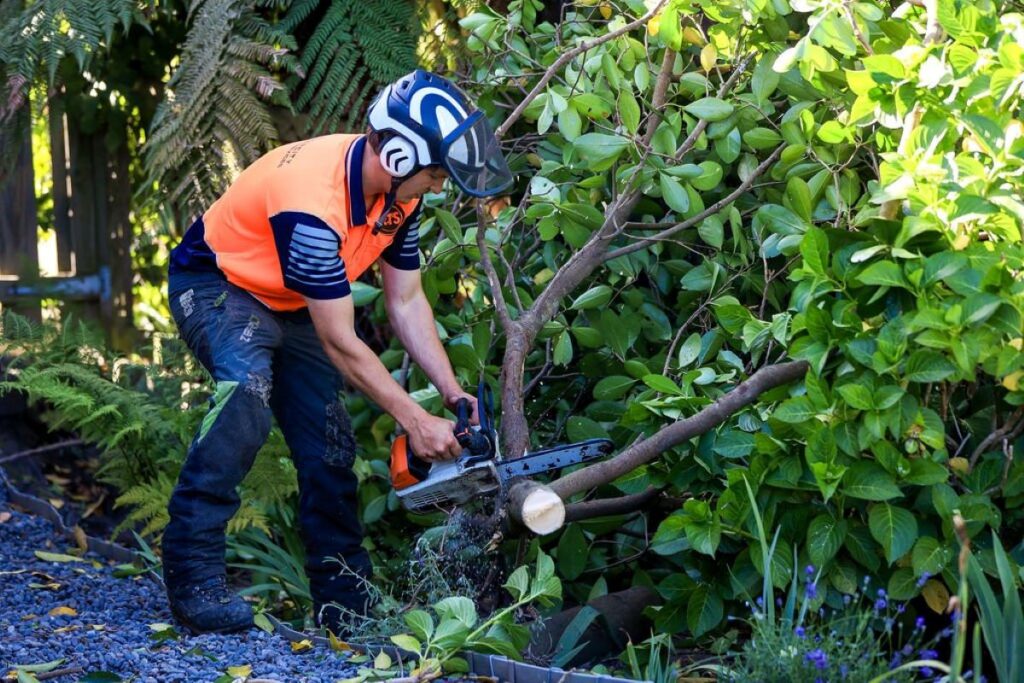
Can Regular Tree Lopping Extend the Lifespan of Trees?
Regular tree lopping plays a vital role in extending tree longevity through strategic maintenance and care. Professional tree lopping services help trees thrive by:
- Reducing weight distribution across major limbs
- Minimising strain on the root system
- Preventing bark damage from rubbing branches
- Limiting resource competition between branches
The removal of unnecessary growth allows trees to direct their energy towards essential functions. This targeted approach strengthens the tree’s core structure and promotes robust development of:
- Root systems
- Main trunk
- Primary branches
- New growth points
Research indicates that well-maintained trees can live 20-30% longer than their unmaintained counterparts. This increased lifespan stems from reduced physical stress on the tree’s major components and improved resource allocation throughout the system.
Proper lopping techniques create balanced growth patterns that help trees withstand:
- Strong winds
- Heavy rainfall
- Temperature fluctuations
- Seasonal changes
A consistent maintenance schedule allows early detection of potential issues before they become severe problems. This proactive approach helps preserve the tree’s structural integrity and natural defence mechanisms against diseases and pests.
The key to maximising tree longevity lies in establishing a regular lopping routine tailored to each tree’s specific needs, species characteristics, and growth patterns. Professional arborists can develop customised maintenance plans that account for these individual factors while promoting optimal health and vitality.
How Does Tree Lopping Enhance Aesthetics and Property Value?
Well-maintained trees create an immediate visual impact on any property’s appearance. Professional tree lopping transforms unkempt, overgrown trees into stunning landscape features that enhance the property’s aesthetic appeal.
A properly lopped tree displays:
- Balanced branch distribution
- Clean, defined shape
- Healthy, vibrant foliage
- Proportional size relative to surroundings
Real estate experts note that properties with expertly maintained trees can command 5-15% higher market values compared to similar properties with untended trees. This increase stems from:
- Enhanced kerb appeal
- Improved property photographs for listings
- Greater perceived property care and maintenance
- Added shade and natural cooling benefits
Tree lopping creates spaces that feel organised and intentional, turning outdoor areas into natural extensions of living spaces. The aesthetic benefits extend beyond individual properties to elevate entire neighbourhood appearances.
Strategic tree lopping also allows property owners to:
- Frame desirable views
- Create privacy screens
- Define outdoor spaces
- Establish focal points in garden designs
Professional tree lopping services understand how to shape trees while preserving their natural form, resulting in an authentic, polished look that appeals to potential buyers and enhances the property’s market position.
What Additional Benefits Does Tree Lopping Provide for Landscaping?
Tree lopping creates valuable opportunities for enhanced landscape utilisation through strategic branch management. The removal of lower branches opens up significant space beneath tree canopies, transforming previously unused areas into functional zones for various activities.
Property owners can establish:
- Shade gardens featuring plants that thrive in filtered light
- Children’s play areas protected from direct sun
- Outdoor seating arrangements for relaxation
- Small vegetable patches or herb gardens
- Storage spaces for garden equipment
The space optimisation extends beyond the immediate tree surroundings. Professional tree lopping services help create clear sight lines across properties, enabling better integration of different landscape elements. This spatial planning allows for:
- Installation of garden paths
- Addition of water features
- Placement of outdoor furniture
- Creation of entertainment areas
- Implementation of landscape lighting
Large trees often dominate garden spaces, but strategic lopping helps balance their presence with other landscape features. The careful reduction of tree bulk creates room for:
- Additional plantings
- Decorative elements
- Functional structures
- Garden art installations
- Improved traffic flow
Professional tree lopping services assess each tree’s structure to determine optimal cutting points that maximise usable space while maintaining the tree’s health and stability.
Why Should You Hire Professional Tree Lopping Services?
Professional tree loppers bring essential expertise and safety measures to tree lopping operations that DIY attempts cannot match. These certified specialists possess in-depth knowledge of tree biology, growth patterns, and structural integrity – critical factors in performing successful lopping procedures.
What Do Certified Arborists Assess Before Starting Work?
Certified arborists conduct thorough assessments before any work begins:
- Tree health evaluation
- Disease identification
- Structural weakness detection
- Risk assessment of surrounding properties
- Analysis of local regulations and permit requirements
What Equipment Do Professional Arborists Use for Tree Lopping?
The technical precision required for proper tree lopping demands specialised equipment and techniques. Professional arborists utilise:
- Industrial-grade cutting tools
- Safety harnesses and protective gear
- Hydraulic lifts and climbing equipment
- Precision cutting methods that protect tree health
Why Is Risk Management Important in Tree Lopping Operations?
Risk management stands as a paramount concern in tree lopping operations. Professional services provide:
- Comprehensive insurance coveragePublic liability protection
- Professional indemnity insurance
- Workers’ compensation
- Safety protocolsTraffic management plans
- Emergency response procedures
- Site-specific risk assessments
How Do Professional Arborists Ensure Compliance with Local Regulations?
Professional arborists also ensure compliance with local council regulations and obtain necessary permits for tree lopping work. Their expertise helps prevent common issues such as:
- Improper cutting techniques leading to tree damage
- Accidental property damage
- Personal injury risks
- Legal complications from unauthorised work
The investment in professional tree lopping services safeguards both property and tree health through expert care and risk mitigation strategies.
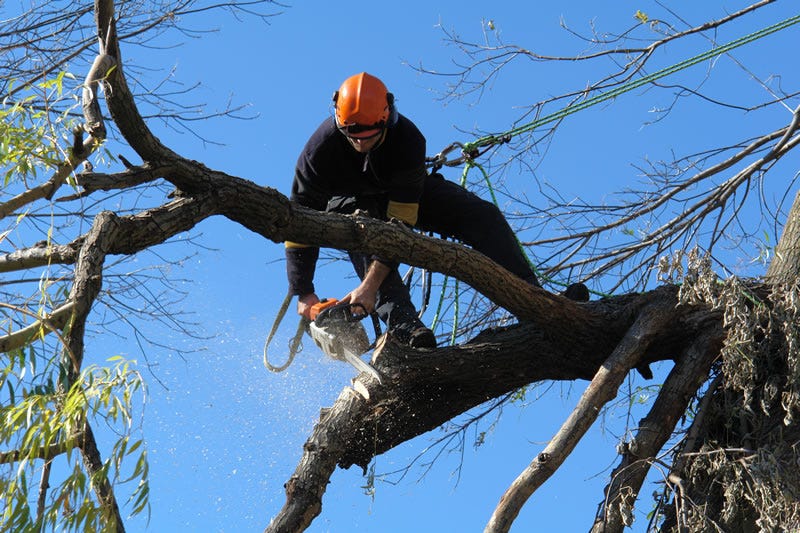
What Are the Steps to Hiring a Reliable Tree Lopping Company?
Finding a trustworthy tree lopping service requires careful research and verification. Here’s a systematic approach to selecting the right professionals:
1. Gather Local Recommendations
- Ask neighbours and friends about their experiences
- Check online review platforms for customer feedback
- Research local community forums and social media groups
2. Verify Essential Credentials
- Valid business licence and registration
- Public liability insurance coverage
- Professional indemnity insurance
- Workers’ compensation insurance
- Arborist certifications
3. Request Multiple Quotes
- Get detailed written estimates
- Compare service inclusions
- Check equipment and safety protocols
- Assess clean-up and waste removal services
4. Review Past Work
- Ask for a portfolio of similar projects
- Request references from previous clients
- Visit completed job sites if possible
5. Confirm Legal Compliance
- Check council permit requirements
- Ensure compliance with local tree preservation laws
- Verify environmental protection measures
A reliable tree lopping company should provide clear documentation of their qualifications and openly discuss their approach to tree care. The right service provider prioritises both tree health and customer satisfaction while maintaining the highest safety standards.
Related : How to Choose the Right Tree Loppers Near Me for the Job


